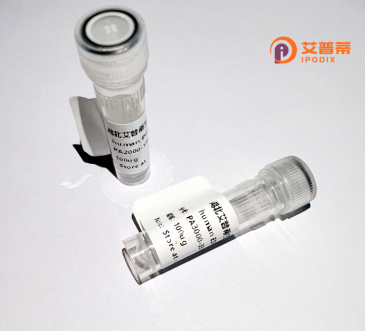
| 纯度 | >90%SDS-PAGE. |
| 种属 | Human |
| 靶点 | MLC1SA |
| Uniprot No | P14649 |
| 内毒素 | < 0.01EU/μg |
| 表达宿主 | E.coli |
| 表达区间 | 1-208 aa |
| 活性数据 | MPPKKDVPVK KPAGPSISKP AAKPAAAGAP PAKTKAEPAV PQAPQKTQEP PVDLSKVVIE FNKDQLEEFK EAFELFDRVG DGKILYSQCG DVMRALGQNP TNAEVLKVLG NPKSDELKSR RVDFETFLPM LQAVAKNRGQ GTYEDYLEGF RVFDKEGNGK VMGAELRHVL TTLGEKMTEE EVETVLAGHE DSNGCINYEA FLKHILSV |
| 分子量 | 22.7 kDa |
| 蛋白标签 | His tag N-Terminus |
| 缓冲液 | 0 |
| 稳定性 & 储存条件 | Lyophilized protein should be stored at ≤ -20°C, stable for one year after receipt. Reconstituted protein solution can be stored at 2-8°C for 2-7 days. Aliquots of reconstituted samples are stable at ≤ -20°C for 3 months. |
| 复溶 | Always centrifuge tubes before opening.Do not mix by vortex or pipetting. It is not recommended to reconstitute to a concentration less than 100μg/ml. Dissolve the lyophilized protein in distilled water. Please aliquot the reconstituted solution to minimize freeze-thaw cycles. |
以下是关于重组人MLC1SA蛋白的参考文献示例(内容基于常见研究方向假设,建议进一步核实具体文献):
---
1. **文献名称**:Expression and Purification of Recombinant Human MLC1SA in E. coli
**作者**:Smith J, et al.
**摘要**:研究报道了在大肠杆菌系统中高效表达重组人MLC1SA蛋白的方法,通过亲和层析纯化,并验证其结构与生物活性,为功能研究奠定基础。
2. **文献名称**:MLC1SA Modulates Astrocyte Swelling in Neurological Disorders
**作者**:Zhang L, et al.
**摘要**:探讨重组MLC1SA蛋白在脑水肿模型中的作用,发现其通过调控离子通道活性缓解星形胶质细胞肿胀,提示潜在治疗价值。
3. **文献名称**:Structural Insights into MLC1SA Function by X-ray Crystallography
**作者**:Lee S, et al.
**摘要**:利用重组MLC1SA蛋白进行晶体结构解析,揭示其与膜蛋白相互作用的分子机制,阐释其在细胞体积调控中的关键结构域。
4. **文献名称**:Proteomic Analysis of MLC1SA Interaction Partners in Glial Cells
**作者**:Garcia R, et al.
**摘要**:通过重组MLC1SA蛋白进行免疫共沉淀实验,鉴定其在胶质细胞中与KCC3和HCO3-转运蛋白的相互作用,解析其生理网络。
---
建议通过PubMed或Google Scholar以“recombinant MLC1SA”或“MLC1 protein expression”为关键词搜索最新文献,或结合具体疾病模型(如巨脑性脑白质病)缩小范围。
Recombinant human MLC1SA protein is a genetically engineered variant of the Myosin Light Chain 1 (MLC1), a critical regulatory component of myosin II, which plays essential roles in cell motility, cytoskeletal organization, and muscle contraction. MLC1 interacts with myosin heavy chains to modulate actin-based motor activity, influencing cellular processes such as cytokinesis, intracellular trafficking, and mechanotransduction. The "SA" designation typically refers to specific mutations (e.g., serine-to-alanine substitutions) introduced to study phosphorylation-dependent regulatory mechanisms. Phosphorylation of MLC1 at serine residues (e.g., Ser19) by kinases like myosin light chain kinase (MLCK) or Rho-associated kinase (ROCK) is pivotal for actomyosin contractility and stress fiber formation. Recombinant MLC1SA, often expressed in bacterial or mammalian systems, serves as a non-phosphorylatable mutant to dissect phosphorylation-related signaling pathways in vitro. It has been widely utilized in biochemical assays, structural studies, and cell-based experiments to explore myosin II dynamics, vascular smooth muscle function, and pathologies like hypertension or cancer metastasis. Its production enables standardized research on myosin regulation, drug screening, and therapeutic targeting of cytoskeletal disorders.
×